Communications and High-Precision Positioning (CHP2): Hardware Architecture, Implementation, and Validation
Abstract
1. Introduction
1.1. System Overview
1.2. Prior Work
1.3. Motivation, Limitations, and Applications
1.4. Hardware Implementation
1.5. Contributions
- Implement a modern TWR system on COTS hardware that simultaneously enables network communications, distributed coherence, and relative positioning using a single, narrowband waveform.
- Implement and validate efficient, real-time, oversampled ToA estimation techniques on this COTS processing hardware.
- Provide detailed descriptions of the processing architecture and firmware implementation on the ZCU102 evaluation hardware.
- Demonstrate high-precision, over-the-air ranging capabilities (<2 cm cabled, <10 cm airborne) using moderately low bandwidth (10 MHz) in experimental flight tests.
1.6. Organization
2. Background
2.1. Positioning, Navigation, and Timing (PNT) Systems
2.2. Vehicular Applications
2.3. COTS RF Hardware
2.4. Spectral Convergence
2.5. Distributed Coherence and MIMO Extensions
3. Model Definitions
3.1. Time Model
3.2. Propagation Model
4. Estimator Definitions
4.1. Critically Sampled Matched Filter
4.2. Oversampled Reference Bank
4.3. Interpolated Correlator
4.4. ToF and Range Estimation
5. System Architecture
5.1. Data Link Layer
5.2. Physical Layer
6. COTS Hardware Components
6.1. Motherboard – ZCU102
6.2. Transceiver—FMCOMMS5
6.3. Transmit-Receive Switching Board
6.4. Antennas
6.5. Enclosure
7. Processing Architecture
7.1. CHP2 Physical Layer
7.1.1. Transmit Engine
7.1.2. Receive Engine
7.1.3. Reference Bank ToA Estimation
7.2. Physical Layer Operations
- Carrier Frequency Correction: CHP2 performs two carrier frequency offset (CFO) corrections on the received data. The first correction coarsely estimates the CFO using the pre- and mid-ambles and applies the correction to the data being passed to the communications decoding processing chain. The second correction finely estimates the CFO using the pre- and post-ambles and applies the correction to the data being passed to the ToA correlation engine.
- Pulse Shaping Filter: We apply a raised cosine FIR filter in the Tx and Rx engines to limit the spectral leakage. This filter uses 65 taps, a 0.25 roll-off factor, a 16 symbol span, and 4 samples per symbol.
- Channel Equalizer: We apply a 5-tap adaptive Wiener filter to the received data in the communications processing chain to mitigate multi-path effects. This filter is evaluated on each reception using the pre-amble.
- Automatic Gain Control: We employ automatic gain control (AGC) to maintain a received instantaneous SNR between 20 and 25 dB. This prevents power saturation and starvation as the platforms move closer or farther apart, respectively.
7.3. CHP2 Data Link Layer
7.4. CHP2 Application Layer
7.5. ZynqMP Hardware Utilization
8. Experimental Results
8.1. Cabled Experiments
8.2. Over-the-Air Demonstrations
8.2.1. VTOL Test
8.2.2. Longer-Range Tests
9. Conclusions
Author Contributions
Funding
Institutional Review Board Statement
Informed Consent Statement
Data Availability Statement
Conflicts of Interest
Abbreviations
| A2A | Air-to-air |
| A2G | Air-to-ground |
| ADC | Analog-to-digital converter |
| AGC | Automatic gain control |
| APNT | Alternative positioning, navigation, and timing |
| ATM | Air traffic management |
| BPSK | Binary phase-shift keying |
| CHP2 | Communications and High-Precision Positioning |
| CNS | Communications, navigation, and surveillance |
| COTS | Commercial off-the-shelf |
| DME | Distance measuring equipment |
| DSP | Digital signal processing |
| G2G | Ground-to-ground |
| GNSS | Global Navigation Satellite System |
| GPS | Global Positioning System |
| ISNR | Integrated signal-to-noise ratio |
| LDACS1 | L-band Digital Aeronautical Communication System 1 |
| LiDAR | Light detection and ranging |
| LNA | Low-noise amplifier |
| LoS | Line of sight |
| LUT | Lookup table |
| MIMO | Multiple-input, multiple-output |
| MSK | Minimum-shift keying |
| NTP | Network Timing Protocol |
| OCXO | Oven-controlled crystal oscillator |
| OSI | Open Systems Interconnection |
| P-WAM | Passive wide area multilateration |
| PL | Pseudolite |
| PNT | Positioning, navigation, and timing |
| RF | Radio-frequency |
| RFID | Radio-frequency identification |
| RFSoC | RF system-on-chip |
| RTK | Real-time kinematic |
| SDR | Software-defined radio |
| SWaP | Size, weight, and power |
| SWaP-C | Size, weight, power, and cost |
| ToA | Time-of-arrival |
| ToF | Time-of-flight |
| TWR | Two-way ranging |
| UAM | Urban air mobility |
| UAV | Unmanned aerial vehicle |
| UHARS | Ultra High Accuracy Reference System |
| UHD | USRP Hardware Driver |
| USRP | Universal Software Radio Peripheral |
| UWB | Ultra-wideband |
| V2V | Vehicle-to-vehicle |
| VOR | VHF omnidirectional range |
| VTOL | Vertical take-off and landing |
| WAAS | Wide Area Augmentation System |
References
- Zeng, Y.; Zhang, R.; Lim, T.J. Wireless communications with unmanned aerial vehicles: Opportunities and challenges. IEEE Commun. Mag. 2016, 54, 36–42. [Google Scholar] [CrossRef]
- Valavanis, K.P.; Vachtsevanos, G.J. Handbook of Unmanned Aerial Vehicles; Springer: Berlin/Heidelberg, Germany, 2015; Volume 1. [Google Scholar]
- Schoettle, B.; Sivak, M. A Survey of Public Opinion about Autonomous and Self-Driving Vehicles in the US, the UK, and Australia; Technical Report; University of Michigan, Transportation Research Institute: Ann Arbor, MI, USA, 2014. [Google Scholar]
- Thipphavong, D.P.; Apaza, R.; Barmore, B.; Battiste, V.; Burian, B.; Dao, Q.; Feary, M.; Go, S.; Goodrich, K.H.; Homola, J.; et al. Urban air mobility airspace integration concepts and considerations. In Proceedings of the 2018 Aviation Technology, Integration, and Operations Conference, Atlanta, GE, USA, 25–29 June 2018; p. 3676. [Google Scholar]
- Straubinger, A.; Rothfeld, R.; Shamiyeh, M.; Büchter, K.D.; Kaiser, J.; Plötner, K.O. An overview of current research and developments in urban air mobility–Setting the scene for UAM introduction. J. Air Transp. Manag. 2020, 87, 101852. [Google Scholar] [CrossRef]
- Fox, D.; Burgard, W.; Thrun, S. The dynamic window approach to collision avoidance. IEEE Robot. Autom. Mag. 1997, 4, 23–33. [Google Scholar] [CrossRef]
- Tomlin, C.; Pappas, G.J.; Sastry, S. Conflict resolution for air traffic management: A study in multiagent hybrid systems. IEEE Trans. Autom. Control 1998, 43, 509–521. [Google Scholar] [CrossRef]
- Schwarting, W.; Alonso-Mora, J.; Rus, D. Planning and decision-making for autonomous vehicles. Annu. Rev. Control Robot. Auton. Syst. 2018, 1, 187–210. [Google Scholar] [CrossRef]
- Sun, W.; Ström, E.G.; Brännström, F.; Sou, K.C.; Sui, Y. Radio resource management for D2D-based V2V communication. IEEE Trans. Veh. Technol. 2015, 65, 6636–6650. [Google Scholar] [CrossRef]
- Han, S.; Gong, Z.; Meng, W.; Li, C.; Gu, X. Future alternative positioning, navigation, and timing techniques: A survey. IEEE Wirel. Commun. 2016, 23, 154–160. [Google Scholar] [CrossRef]
- Paul, B.; Chiriyath, A.R.; Bliss, D.W. Survey of RF communications and sensing convergence research. IEEE Access 2017, 5, 252–270. [Google Scholar] [CrossRef]
- Herschfelt, A.; Yu, H.; Wu, S.; Lee, H.; Bliss, D.W. Joint Positioning-Communications System Design: Leveraging Phase-Accurate Time-of-Flight Estimation and Distributed Coherence. In Proceedings of the 2018 52nd Asilomar Conference on Signals, Systems, and Computers, Pacific Grove, CA, USA, 28–31 October 2018; pp. 433–437. [Google Scholar]
- Srinivas, S.; Herschfelt, A.; Yu, H.; Wu, S.; Li, Y.; Lee, H.; Chakrabarti, C.; Bliss, D.W. Communications and high-precision positioning (chp2): Enabling secure cns and apnt for safety-critical air transport systems. In Proceedings of the 2020 AIAA/IEEE 39th Digital Avionics Systems Conference (DASC), San Antonio, TX, USA, 11–15 October 2020; pp. 1–6. [Google Scholar]
- Herschfelt, A.; Yu, H.; Wu, S.; Srinivas, S.; Li, Y.; Sciammetta, N.; Smith, L.; Rueger, K.; Lee, H.; Chakrabarti, C.; et al. Joint positioning-communications system design and experimental demonstration. In Proceedings of the 2019 IEEE/AIAA 38th Digital Avionics Systems Conference (DASC), San Diego, CA, USA, 8–12 September 2019; pp. 1–6. [Google Scholar]
- Bidigare, P.; Madhow, U.; Mudumbai, R.; Scherber, D. Attaining fundamental bounds on timing synchronization. In Proceedings of the Acoustics, Speech and Signal Processing (ICASSP), Kyoto, Japan, 25–30 March 2012; pp. 5229–5232. [Google Scholar]
- Bidigare, P.; Oyarzyn, M.; Raeman, D.; Chang, D.; Cousins, D.; O’Donnell, R.; Obranovich, C.; Brown, D.R. Implementation and demonstration of receiver-coordinated distributed transmit beamforming across an ad-hoc radio network. In Proceedings of the 2012 Conference Record of the Forty Sixth Asilomar Conference on Signals, Systems and Computers (ASILOMAR), Pacific Grove, CA, USA, 4–7 November 2012; pp. 222–226. [Google Scholar]
- Bidigare, P.; Pruessing, S.; Raeman, D.; Scherber, D.; Madhow, U.; Mudumbai, R. Initial over-the-air performance assessment of ranging and clock synchronization using radio frequency signal exchange. In Proceedings of the Statistical Signal Processing Workshop (SSP), 2012 IEEE, Ann Arbor, MI, USA, 5–8 August 2012; pp. 273–276. [Google Scholar]
- SOCs, mpsocs and RFSoCs.
- Amakawa, S.; Aslam, Z.; Buckwater, J.; Caputo, S.; Chaoub, A.; Chen, Y.; Corre, Y.; Fujishima, M.; Ganghua, Y.; Gao, S.; et al. White Paper on RF Enabling 6G—-Opportunities and Challenges from Technology to Spectrum; University of Oulu: Oulu, Finland, 2021; ISBN 978-952-62-2841-9. [Google Scholar]
- Shepard, D.P.; Bhatti, J.A.; Humphreys, T.E.; Fansler, A.A. Evaluation of smart grid and civilian UAV vulnerability to GPS spoofing attacks. In Proceedings of the Radionavigation Laboratory Conference Proceedings, Nashville, TN, USA, 17–21 September 2012. [Google Scholar]
- Humphreys, T. Statement on the Vulnerability of Civil Unmanned Aerial Vehicles and Other Systems to Civil GPS Spoofing; University of Texas at Austin: Austin, TX, USA, 2012; pp. 1–16. [Google Scholar]
- Kerns, A.J.; Shepard, D.P.; Bhatti, J.A.; Humphreys, T.E. Unmanned aircraft capture and control via GPS spoofing. J. Field Robot. 2014, 31, 617–636. [Google Scholar] [CrossRef]
- Dow, J.M.; Neilan, R.E.; Rizos, C. The international GNSS service in a changing landscape of global navigation satellite systems. J. Geod. 2009, 83, 191–198. [Google Scholar] [CrossRef]
- Parkinson, B.W.; Enge, P.; Axelrad, P.; Spilker Jr, J.J. Global Positioning System: Theory and Applications; American Institute of Aeronautics and Astronautics: Reston, VA, USA, 1996; Volume II. [Google Scholar]
- Kasliwal, A.; Furbush, N.J.; Gawron, J.H.; McBride, J.R.; Wallington, T.J.; De Kleine, R.D.; Kim, H.C.; Keoleian, G.A. Role of flying cars in sustainable mobility. Nat. Commun. 2019, 10, 1–9. [Google Scholar] [CrossRef] [PubMed]
- Lo, S.; Chen, Y.H.; Enge, P.; Peterson, B.; Erikson, R.; Lilley, R. Distance measuring equipment accuracy performance today and for future alternative position navigation and timing (APNT). In Proceedings of the 26th International Technical Meeting of The Satellite Division of the Institute of Navigation (ION GNSS 2013), Nashville, TN, USA, 16–20 September 2013; pp. 711–721. [Google Scholar]
- Pourvoyeur, K.; Mathias, A.; Heidger, R. Investigation of measurement characteristics of MLAT/WAM and ADS-B. In Proceedings of the 2011 Tyrrhenian International Workshop on Digital Communications-Enhanced Surveillance of Aircraft and Vehicles, Capri, Italy, 12–14 September 2011; pp. 203–206. [Google Scholar]
- Garcia, M.A.; Mueller, R.; Innis, E.; Veytsman, B. An enhanced altitude correction technique for improvement of WAM position accuracy. In Proceedings of the 2012 Integrated Communications, Navigation and Surveillance Conference, Herndon, VA, USA, 24–26 April 2012; p. A4-1. [Google Scholar]
- Neufeldt, H.; Stanzel, S. An operational WAM in frankfurt airspace. In Proceedings of the 2013 14th International Radar Symposium (IRS), Dresden, Germany, 19–21 June 2013; Volume 2, pp. 561–566. [Google Scholar]
- Jan, S.S.; Jheng, S.L.; Chen, Y.H.; Lo, S. Evaluation of positioning algorithms for wide area multilateration based alternative positioning navigation and timing (APNT) using 1090 MHz ADS-B signals. In Proceedings of the 27th International Technical Meeting of the Satellite Division of the Institute of Navigation, ION GNSS 2014. Institute of Navigation, Tampa, FL, USA, 8–12 September 2014; pp. 3016–3028. [Google Scholar]
- ADS-B Frequently Asked Questions (FAQs). Available online: https://www.faa.gov/nextgen/programs/adsb/faq/#i2 (accessed on 17 October 2010).
- Barnes, J.; Wang, J.; Rizos, C.; Tsujii, T. The performance of a pseudolite-based positioning system for deformation monitoring. In Proceedings of the 2nd Symp. on Geodesy for Geotechnical & Structural Applications, Berlin, Germany, 21–24 May 2002; pp. 21–24. [Google Scholar]
- Shutin, D.; Schneckenburger, N.; Walter, M.; Schnell, M. LDACS1 ranging performance—An analysis of flight measurement results. In Proceedings of the 2013 IEEE/AIAA 32nd Digital Avionics Systems Conference (DASC), East Syracuse, NY, USA, 5–10 October 2013; p. 3C6-1. [Google Scholar]
- Schnell, M.; Epple, U.; Shutin, D.; Schneckenburger, N. LDACS: Future aeronautical communications for air-traffic management. IEEE Commun. Mag. 2014, 52, 104–110. [Google Scholar] [CrossRef]
- NSTB/WAAS T&E Team. Wide-Area Augmentation System Performance Analysis Report: Report #64; Technical Report; FAA William J. Hughes Technical Center, Atlantic City International Airport, NJ, 08405, 2018. Available online: https://www.nstb.tc.faa.gov/reports/waaspan64.pdf (accessed on 1 November 2019).
- NovAtel. AdVance® RTK Competitive Analysis; Technical Report; NovAtel: Calgary, AB, Canada, 2022. [Google Scholar]
- Trunzo, A.; Ramirez, R.; Baldwin, J. The UHARS Non-GPS-Based Positioning System. In Proceedings of the 27th International Technical Meeting of the Satellite Division of The Institute of Navigation, Tampa, FL, USA, 8–12 September 2014; pp. 3243–3248. [Google Scholar]
- Guvenc, I.; Sahinoglu, Z. Threshold-based TOA estimation for impulse radio UWB systems. In Proceedings of the 2005 IEEE International Conference on Ultra-Wideband, Zurich, Switzerland, 5–8 September 2005; pp. 420–425. [Google Scholar]
- Alavi, B.; Pahlavan, K. Modeling of the TOA-based distance measurement error using UWB indoor radio measurements. IEEE Commun. Lett. 2006, 10, 275–277. [Google Scholar] [CrossRef]
- Gezici, S.; Poor, H.V. Position estimation via ultra-wide-band signals. Proc. IEEE 2009, 97, 386–403. [Google Scholar] [CrossRef]
- Yassin, A.; Nasser, Y.; Awad, M.; Al-Dubai, A.; Liu, R.; Yuen, C.; Raulefs, R.; Aboutanios, E. Recent Advances in Indoor Localization: A Survey on Theoretical Approaches and Applications. IEEE Commun. Surv. Tutorials 2017, 19, 1327–1346. [Google Scholar] [CrossRef]
- Tsugawa, S.; Kato, S. Energy ITS: Another application of vehicular communications. IEEE Commun. Mag. 2010, 48, 120–126. [Google Scholar] [CrossRef]
- Cailean, A.; Cagneau, B.; Chassagne, L.; Topsu, S.; Alayli, Y.; Blosseville, J.M. Visible light communications: Application to cooperation between vehicles and road infrastructures. In Proceedings of the Intelligent Vehicles Symposium (IV), Madrid, Spain, 3–7 June 2012; pp. 1055–1059. [Google Scholar]
- Eckelmann, S.; Trautmann, T.; Ußler, H.; Reichelt, B.; Michler, O. V2V-Communication, LiDAR System and Positioning Sensors for Future Fusion Algorithms in Connected Vehicles. Transp. Res. Procedia 2017, 27, 69–76. [Google Scholar] [CrossRef]
- Langer, K.D.; Grubor, J. Recent developments in optical wireless communications using infrared and visible light. In Proceedings of the Transparent Optical Networks, 2007, ICTON’07. 9th International Conference on Transparent Optical Networks, Rome, Italy, 1–5 July 2007; Volume 3, pp. 146–151. [Google Scholar]
- Belle, A.; Falcitelli, M.; Petracca, M.; Pagano, P. Development of IEEE802. 15.7 based ITS services using low cost embedded systems. In Proceedings of the ITS Telecommunications (ITST), 2013 3th International Conference on ITS Telecommunications, Tampere, Finland, 5–7 November 2013; pp. 419–425. [Google Scholar]
- Decarli, N.; Guidi, F.; Dardari, D. A novel joint RFID and radar sensor network for passive localization: Design and performance bounds. IEEE J. Sel. Top. Signal Process. 2014, 8, 80–95. [Google Scholar] [CrossRef]
- Lowbridge, P. Low cost millimeter-wave radar systems for intelligent vehicle cruise control applications. Microw. J. 1995, 38, 20–27. [Google Scholar]
- Michael, J. Phased Array Based Radar System for Vehicular Collision Avoidance. U.S. Patent 5,467,072, 14 November 1995. [Google Scholar]
- Kwag, Y.K.; Chung, C.H. UAV based collision avoidance radar sensor. In Proceedings of the 2007 IEEE International Geoscience and Remote Sensing Symposium, Barcelona, Spain, 23–27 July 2007; pp. 639–642. [Google Scholar]
- LeMire, R.A.; Branning, J.M., Jr. Systems and Methods for Collision Avoidance in Unmanned Aerial Vehicles. U.S. Patent 8,378,881, 2 December 2012. [Google Scholar]
- Sarkar, A.; Agarwal, S.; Nath, A. Li-Fi technology: Data transmission through visible light. Int. J. Adv. Res. Comput. Sci. Manag. Stud. 2015, 3, 1–12. [Google Scholar]
- Preethi, S. Collision Avoidance Using Li-Fi Based Inter Vehicle Communication. J. Netw. Secur. 2018, 6, 22–26. [Google Scholar]
- Sabatini, R.; Gardi, A.; Richardson, M. LIDAR obstacle warning and avoidance system for unmanned aircraft. Int. J. Mech. Aerosp. Ind. Mechatronics Eng. 2014, 8, 718–729. [Google Scholar]
- Mukhtar, A.; Xia, L.; Tang, T.B. Vehicle detection techniques for collision avoidance systems: A review. IEEE Trans. Intell. Transp. Syst. 2015, 16, 2318–2338. [Google Scholar] [CrossRef]
- Shaw, D.C.; Shaw, J.Z. Vehicle Collision Avoidance System. U.S. Patent 5,529,138, 25 June 1996. [Google Scholar]
- Orlando, V.A. The mode S beacon radar system. Linc. Lab. J. 1989, 2, 345–362. [Google Scholar]
- Yeste-Ojeda, O.A.; Zambrano, J.; Landry, R. Design of integrated Mode S transponder, ADS-B and distance measuring equipment transceivers. In Proceedings of the Integrated Communications Navigation and Surveillance (ICNS), Herndon, VA, USA, 19–21 April 2016; p. 4E1-1. [Google Scholar]
- Bidigare, P. The Shannon channel capacity of a radar system. In Proceedings of the Signals, Systems and Computers, 2002. Conference Record of the Thirty-Sixth Asilomar Conference on Signals, Systems & Computers, Pacific Grove, CA, USA, 3–6 November 2002; Volume 1, pp. 113–117. [Google Scholar]
- Akeela, R.; Dezfouli, B. Software-defined Radios: Architecture, state-of-the-art, and challenges. Comput. Commun. 2018, 128, 106–125. [Google Scholar] [CrossRef]
- Zhang, J.; Jia, J.; Zhang, Q.; Lo, E.M. Implementation and evaluation of cooperative communication schemes in software-defined radio testbed. In Proceedings of the 2010 Proceedings IEEE INFOCOM, San Diego, CA, USA, 14–19 March 2010; pp. 1–9. [Google Scholar]
- Holtom, J.; Gubash, G.; Herschfelt, A.; Ma, O.; Standage-Beier, W.; Yu, H.; Bliss, D.W. Rapid implementation and demonstration of radio applications using wiscanet. In Proceedings of the 2021 IEEE 32nd Annual International Symposium on Personal, Indoor and Mobile Radio Communications (PIMRC), Helsinki, Finland, 13–16 September 2021; pp. 1500–1505. [Google Scholar]
- Ettus Research—The Leader in Software Defined Radio (SDR). Available online: https://www.ettus.com/ (accessed on 21 January 2021).
- National Instruments. Software Defined Radios, 2020 [Online]. Available online: https://www.ni.com/en-us/shop/hardware/software-defined-radios-category.html# (accessed on 1 November 2022).
- USRP Hardware Driver (UHD)—Ettus Research. Available online: https://www.ettus.com/sdr-software/uhd-usrp-hardware-driver/ (accessed on 21 January 2021).
- MathWorks. USRP Support from Communications Toolbox, 2020 [Online]. Available online: https://www.mathworks.com/hardware-support/usrp.html (accessed on 12 November 2020).
- GNURadio. GNURadio: The Free & Open Software Radio Ecosystem; GNURadio, 2020 [Online]. Available online: https://www.gnuradio.org/ (accessed on 12 November 2020).
- GNURadio. GNURadio GitHub Page, 2020 [Online]. Available online: https://github.com/gnuradio/gnuradio (accessed on 12 November 2020).
- Vilches, T.; Dujovne, D. GNUradio and 802.11: Performance evaluation and limitations. IEEE Netw. 2014, 28, 27–31. [Google Scholar] [CrossRef]
- Chiriyath, A.R.; Paul, B.; Jacyna, G.M.; Bliss, D.W. Inner bounds on performance of radar and communications co-existence. IEEE Trans. Signal Process. 2015, 64, 464–474. [Google Scholar] [CrossRef]
- Chiriyath, A.R.; Paul, B.; Bliss, D.W. Radar-Communications Convergence: Coexistence, Cooperation, and Co-Design. IEEE Trans. Cogn. Commun. Netw. 2017, 3, 1–12. [Google Scholar] [CrossRef]
- Mills, D.L. Internet time synchronization: The network time protocol. IEEE Trans. Commun. 1991, 39, 1482–1493. [Google Scholar] [CrossRef]
- Mills, D. Network Time Protocol (Version 3) Specification, Implementation and Analysis; Technical Report; Internet Society: Reston, VA, USA, 1992. [Google Scholar]
- Sivrikaya, F.; Yener, B. Time synchronization in sensor networks: A survey. IEEE Netw. 2004, 18, 45–50. [Google Scholar] [CrossRef]
- Sundararaman, B.; Buy, U.; Kshemkalyani, A.D. Clock synchronization for wireless sensor networks: A survey. Ad hoc Netw. 2005, 3, 281–323. [Google Scholar] [CrossRef]
- Preuss, R.D.; Brown, D.R. Retrodirective distributed transmit beamforming with two-way source synchronization. In Proceedings of the 2010 44th Annual Conference on Information Sciences and Systems (CISS), Princeton, NJ, USA, 17–19 March 2010; pp. 1–6. [Google Scholar]
- Barriac, G.; Mudumbai, R.; Madhow, U. Distributed beamforming for information transfer in sensor networks. In Proceedings of the Third International Symposium on Information Processing in Sensor Networks, Berkeley, CA, USA, 26–27 April 2004; pp. 81–88. [Google Scholar]
- Lin, Z.; Niu, H.; An, K.; Wang, Y.; Zheng, G.; Chatzinotas, S.; Hu, Y. Refracting RIS aided hybrid satellite-terrestrial relay networks: Joint beamforming design and optimization. IEEE Trans. Aerosp. Electron. Syst. 2022, 58, 3717–3724. [Google Scholar] [CrossRef]
- Lin, Z.; An, K.; Niu, H.; Hu, Y.; Chatzinotas, S.; Zheng, G.; Wang, J. SLNR-based secure energy efficient beamforming in multibeam satellite systems. IEEE Trans. Aerosp. Electron. Syst. 2022. [Google Scholar] [CrossRef]
- Lin, Z.; Lin, M.; Wang, J.B.; De Cola, T.; Wang, J. Joint beamforming and power allocation for satellite-terrestrial integrated networks with non-orthogonal multiple access. IEEE J. Sel. Top. Signal Process. 2019, 13, 657–670. [Google Scholar] [CrossRef]
- Niu, H.; Lin, Z.; Chu, Z.; Zhu, Z.; Xiao, P.; Nguyen, H.X.; Lee, I.; Al-Dhahir, N. Joint beamforming design for secure RIS-assisted IoT networks. IEEE Internet Things J. 2022, 10, 1628–1641. [Google Scholar] [CrossRef]
- Bliss, D.W.; Govindasamy, S. Adaptive Wireless Communications: MIMO Channels and Networks; Cambridge University Press: Cambridge, UK, 2013. [Google Scholar]
- Herschfelt, A. Simultaneous Positioning and Communications: Hybrid Radio Architecture, Estimation Techniques, and Experimental Validation. Ph.D. Thesis, Arizona State University, Tempe, AZ, USA, 2019. [Google Scholar]
- Balanis, C.A. Antenna Theory: Analysis and Design; John Wiley & Sons: Hoboken, NJ, USA, 2016. [Google Scholar]
- Srinivas, S.; Herschfelt, A.; Bliss, D.W. Joint positioning-communications system: Optimal distributed coherence and positioning estimators. In Proceedings of the 2019 53rd Asilomar Conference on Signals, Systems, and Computers, Pacific Grove, CA, USA, 3–6 November 2019; pp. 317–321. [Google Scholar]
- Xilinx Inc. Zynq UltraScale+ MPSoC Data Sheet: Overview v1.8; Technical Report; Xilinx Inc.: San Jose, CA, USA, 2019. [Google Scholar]
- Analog Devices. AD-FMCOMMS5-EBZ, 2016 [Online]. Available online: https://www.analog.com/en/design-center/evaluation-hardware-and-software/evaluation-boards-kits/eval-ad-fmcomms5-ebz.html (accessed on 12 November 2020).
- Getz, R. AD-FMCOMMS5-EBZ User Guide, 2021 [Online]. Available online: https://wiki.analog.com/resources/eval/user-guides/ad-fmcomms5-ebz (accessed on 12 November 2020).
- Analog Devices Inc. HDL Reference Designs (2018 Release 1); Technical Report; Analog Devices Inc.: Wilmington, MA, USA, 2018. [Google Scholar]

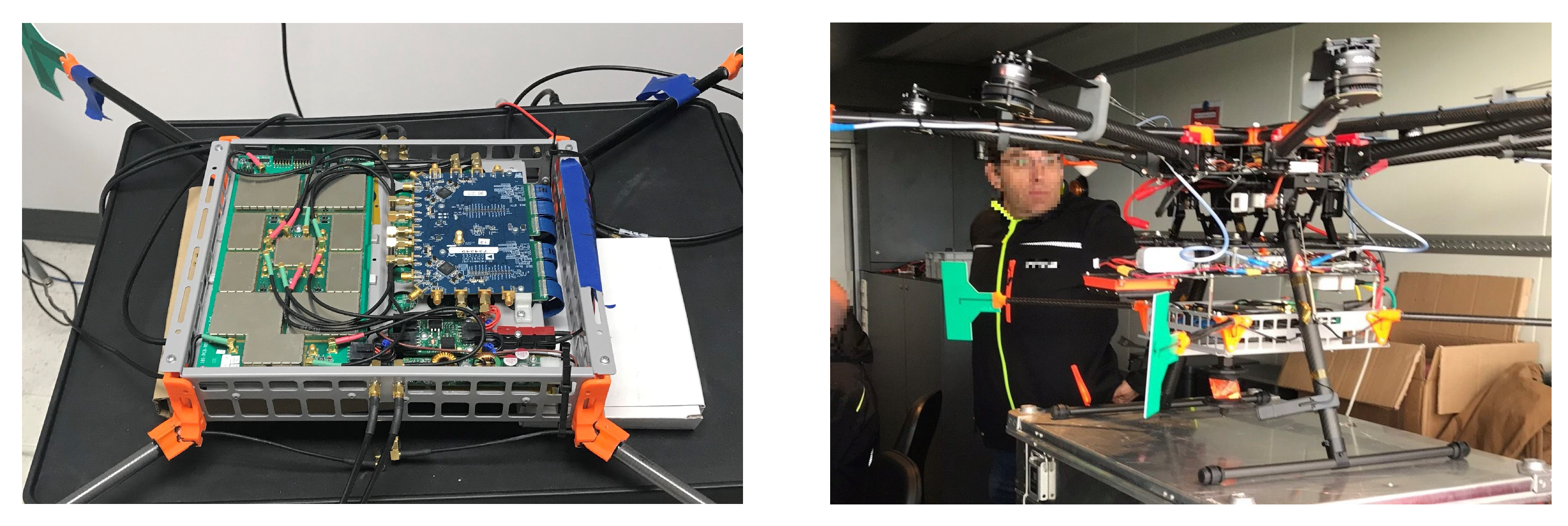
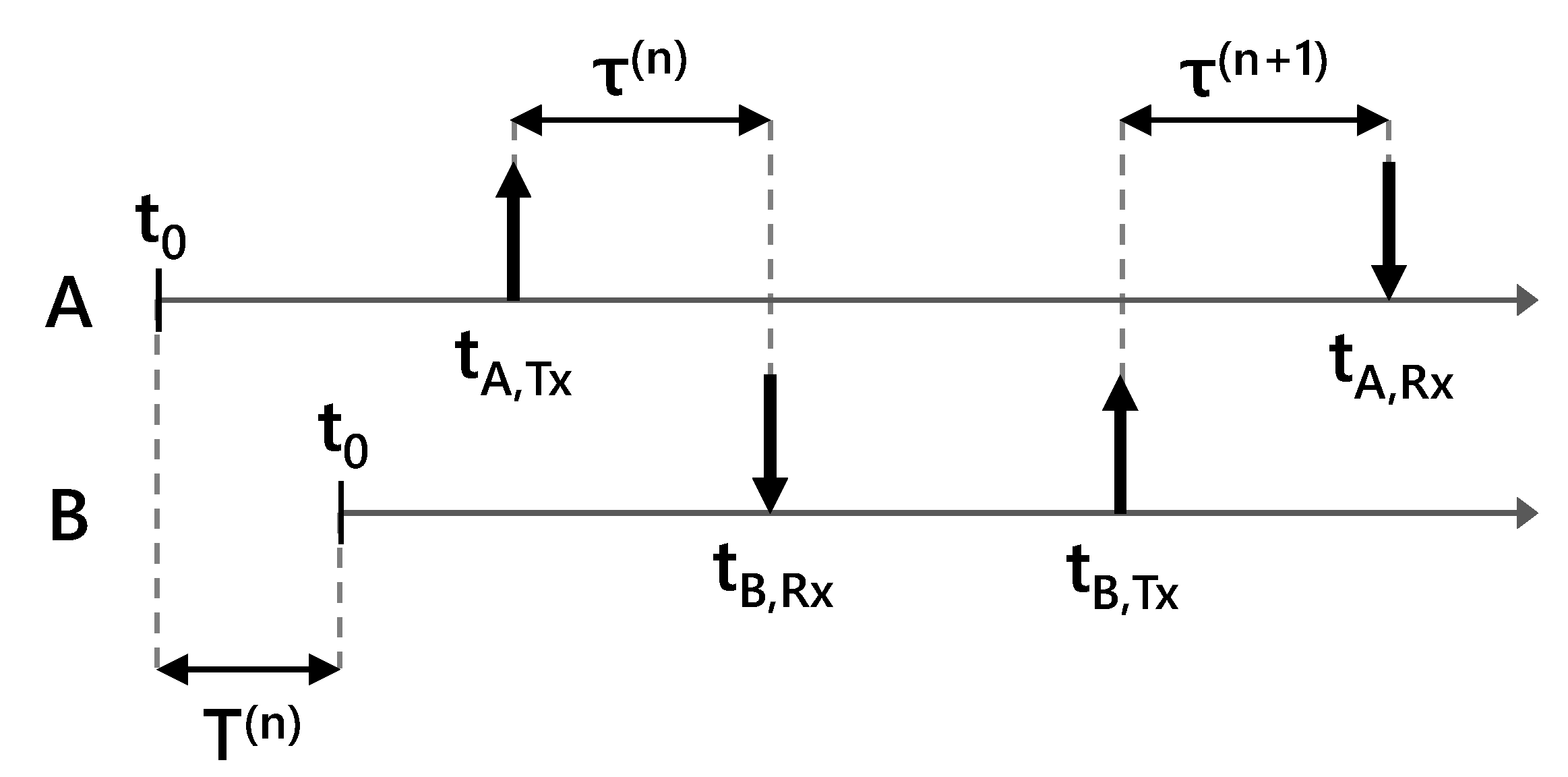

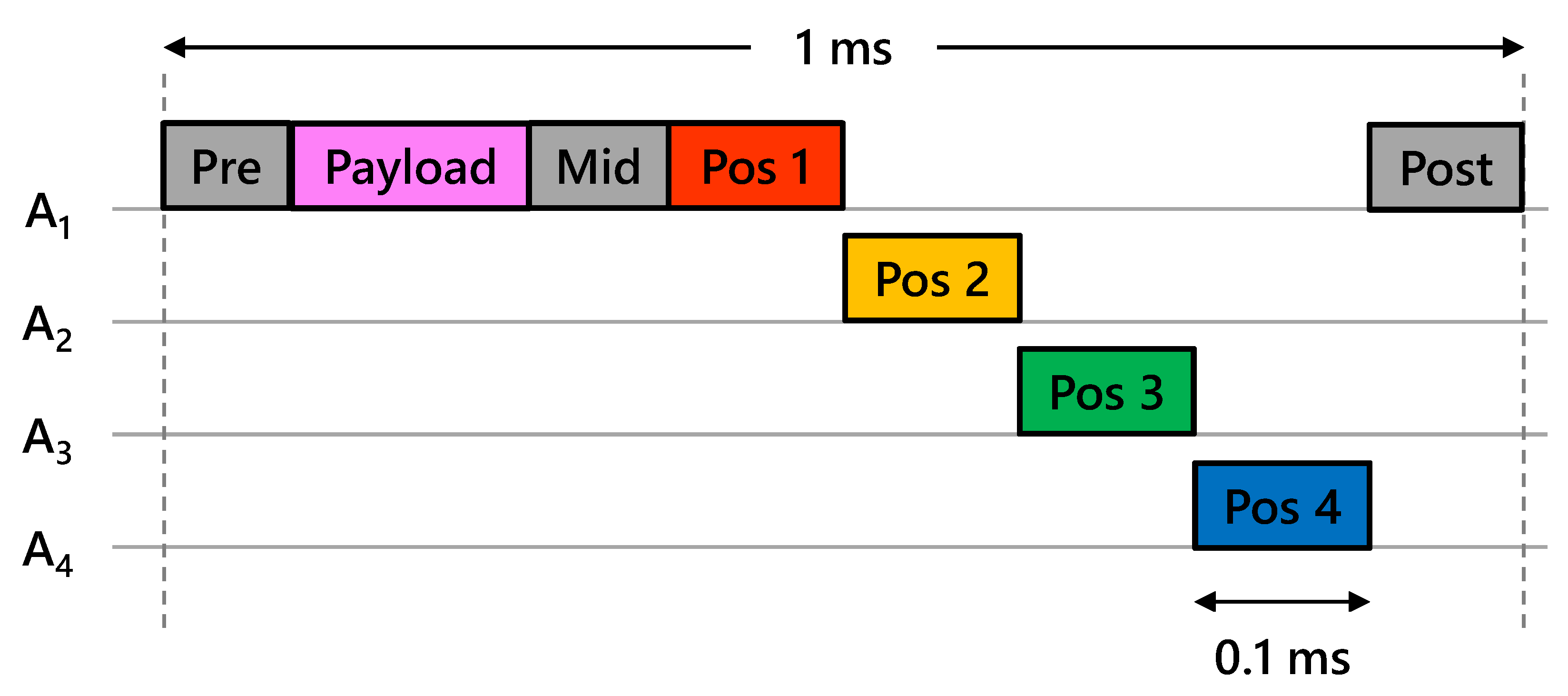
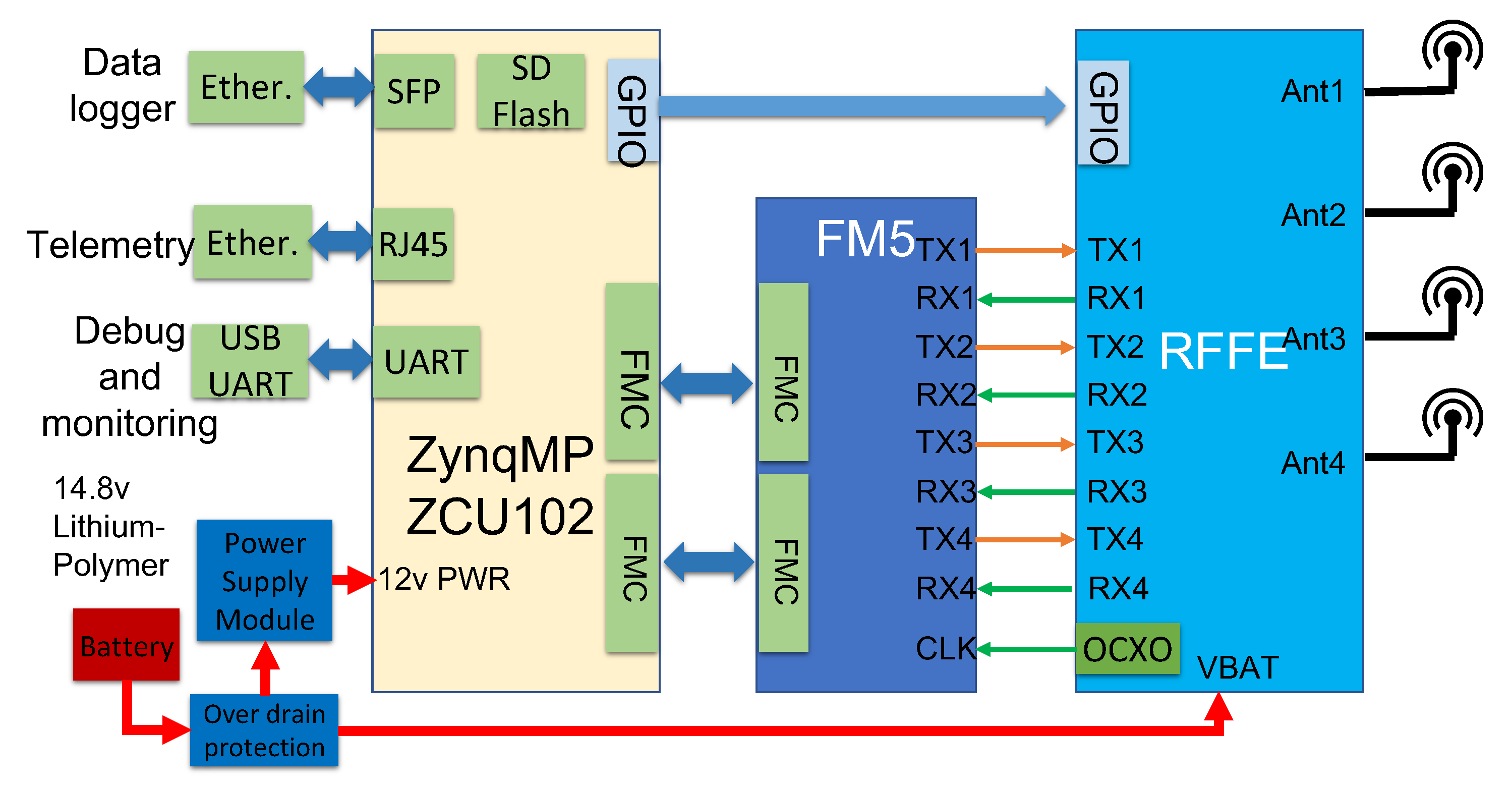
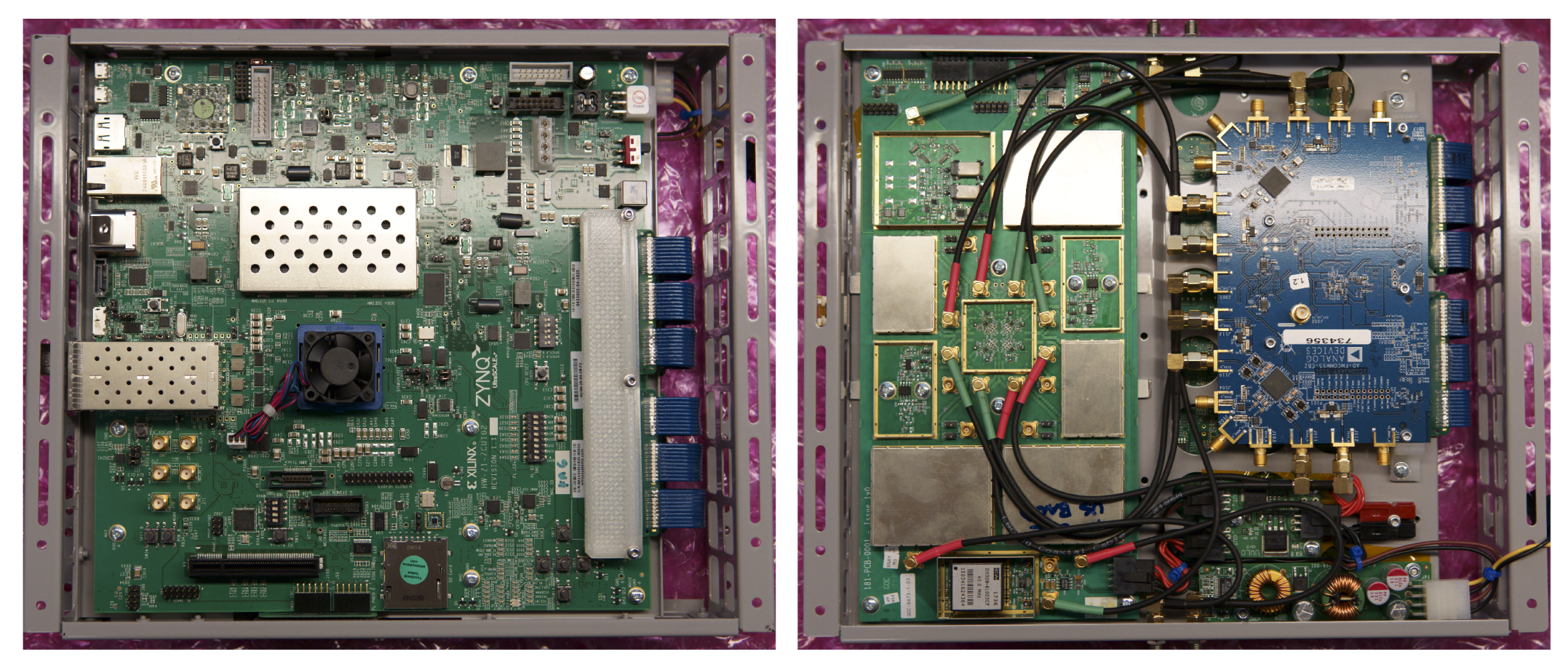


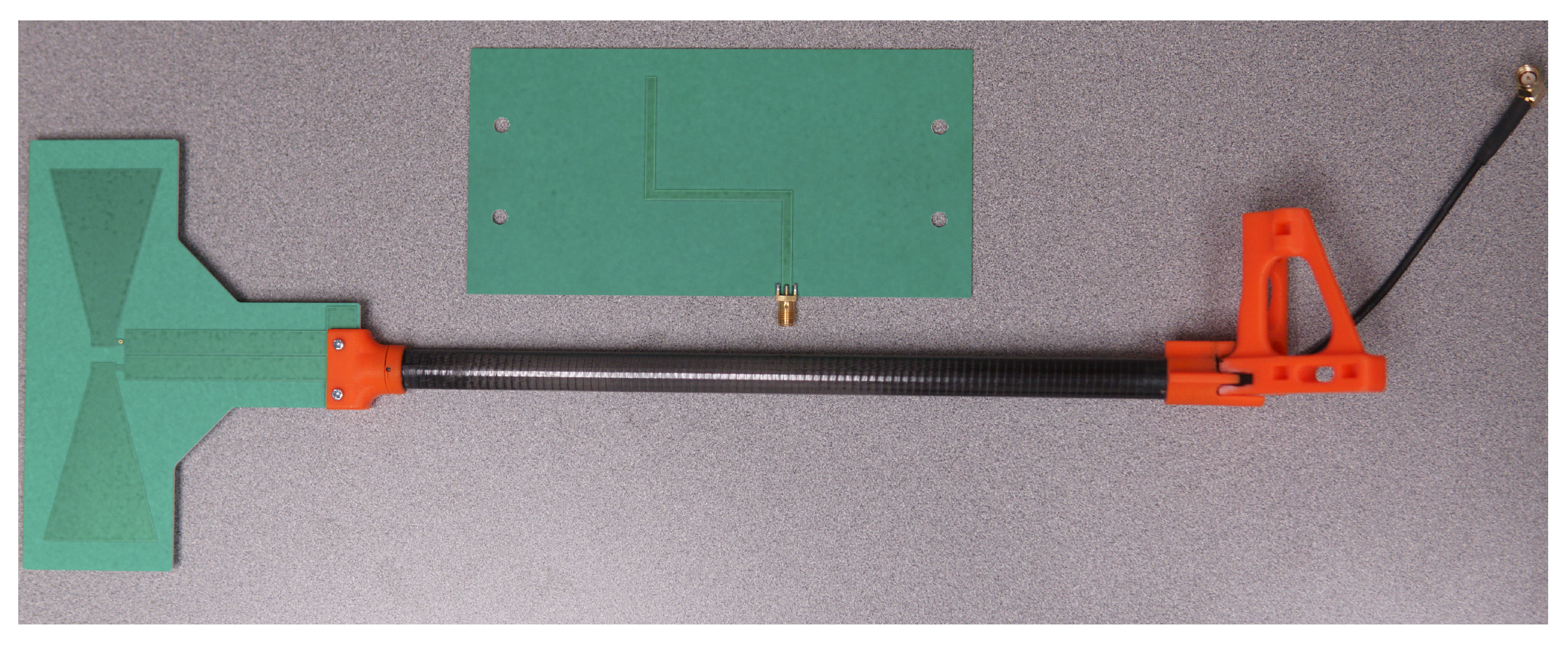


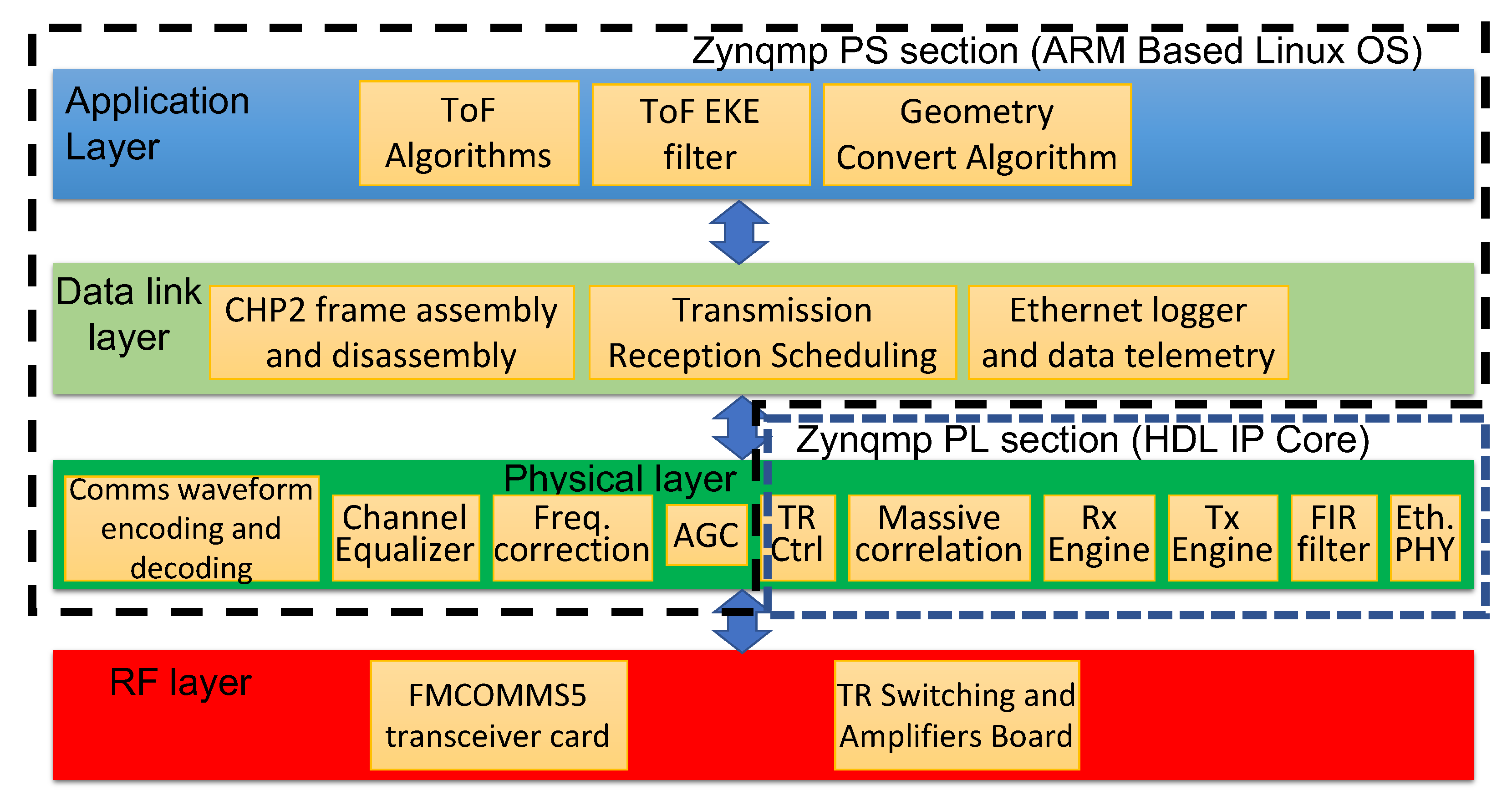




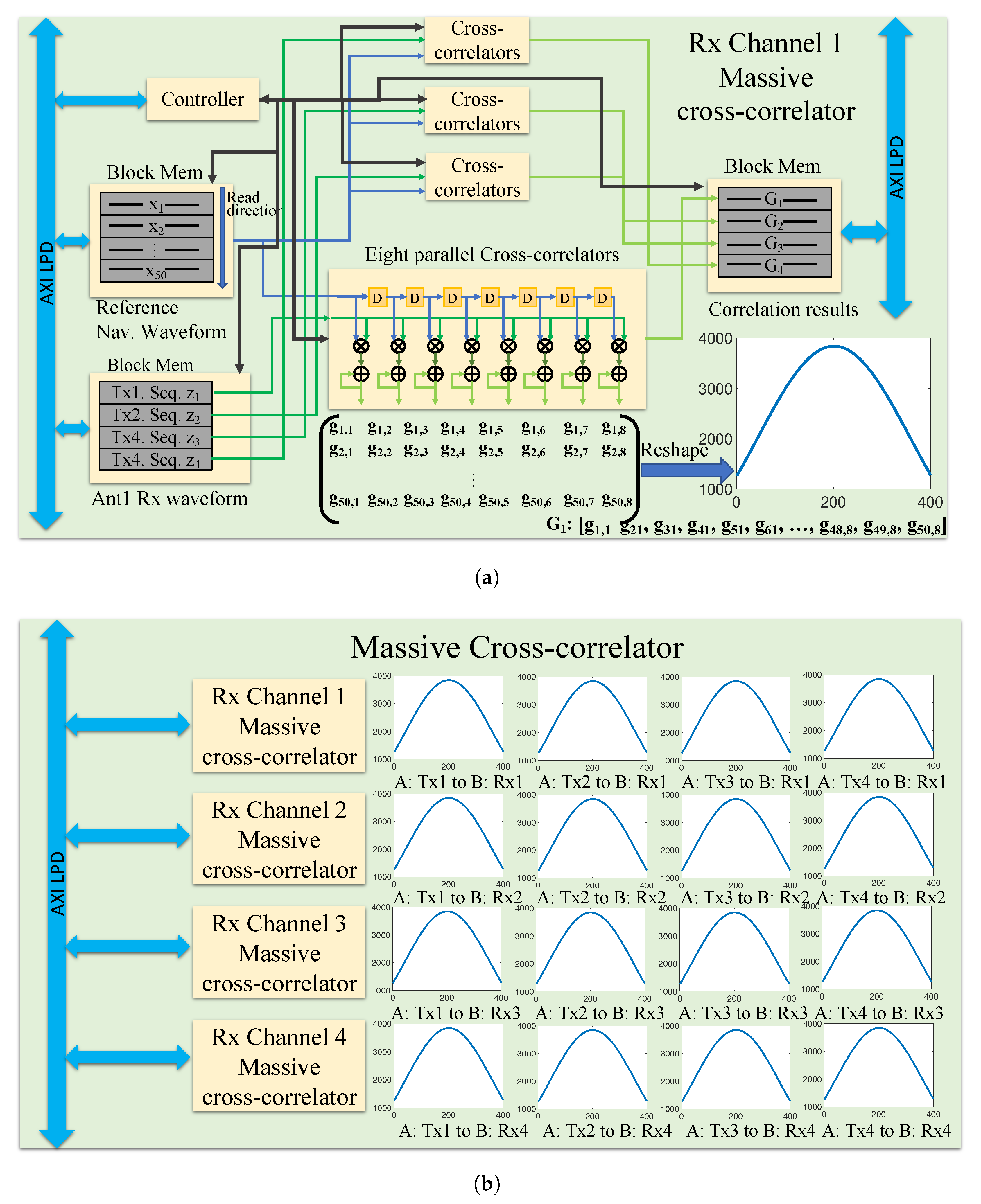

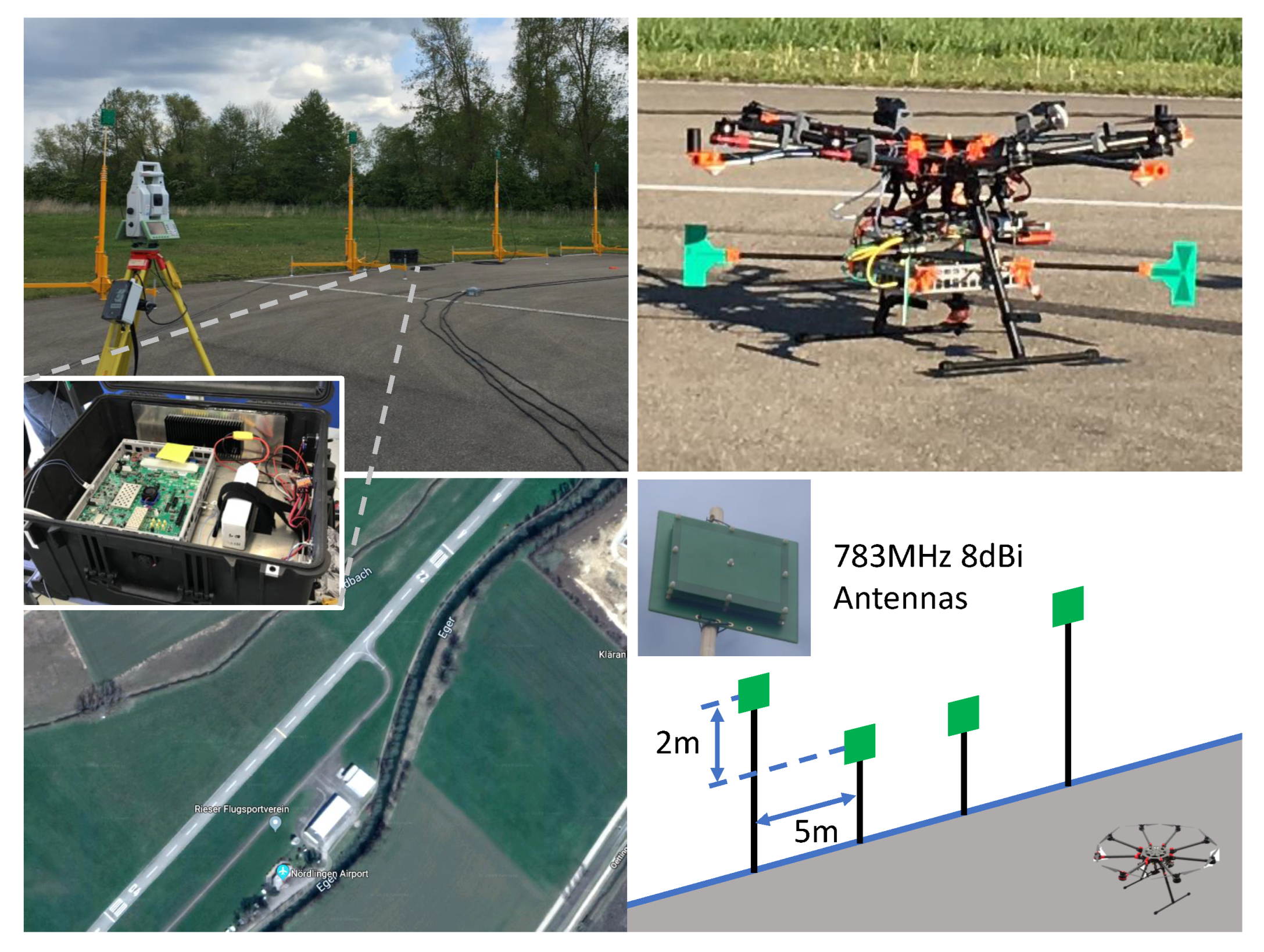

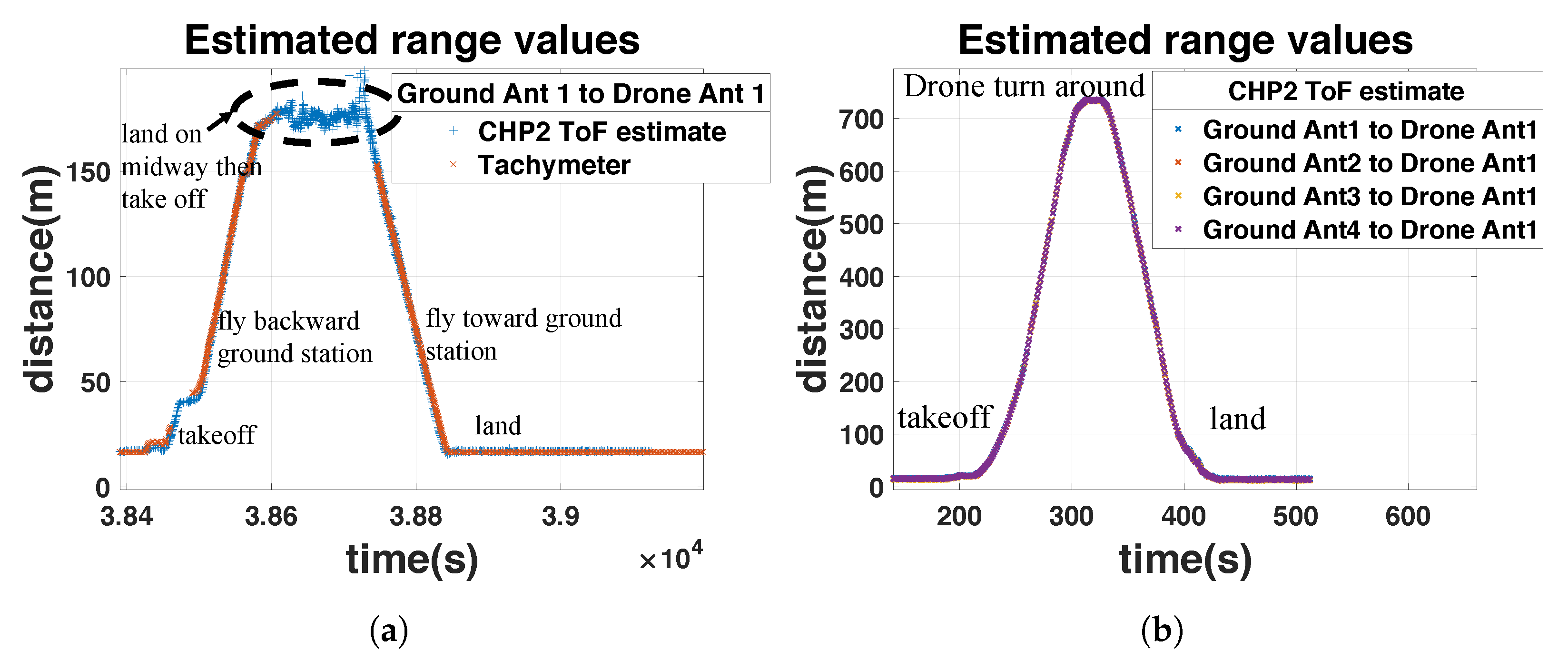
| Label | Tech | Carrier | Bandwidth | Precision | Coverage |
|---|---|---|---|---|---|
| GPS (PL) | Pseudo- | 1.58 GHz (L1) | 1 MHz (Civ) | 5–100 cm | Global |
| Range | 1.23 GHz (L2) | 10 MHz (Mil) | 1–5 cm (PL) | ||
| GPS (WAAS) | PR | 15.345 MHz | 1 m | Global | |
| GPS (RTK) | PR | 15.345 MHz | 1 cm | Global | |
| LDACS1 | 500 kHz | 20 m | 370 km | ||
| VOR | AoA | 108–118 MHz | 10 MHz | 0.35–1.4 | 100–300 km |
| DME | RToF | 960–1215 | 252 × 1 | (Legacy) | 50 km (Close) |
| MHz | MHz | 300 m | 75 km (Mid) | ||
| (Modern) | 250 km (Long) | ||||
| 100 m | |||||
| (ADS-B) | TDoA | (ADS-B) | (ADS-B) | 50–100 m | (ADS-B) |
| P-WAM | 1090 MHz | 50 kHz | 250 km | ||
| 978 MHz | 1.3 MHz | ||||
| UHARS | 10.23 MHz | 20 cm | 50 km | ||
| UWB | 1 GHz | 1–10 cm | Varied. | ||
| CHP2 | Pseudo- | 915 MHz (US) | 10 MHz | 0.1–10 cm | 10 km |
| Range | 783 MHz (EU) |
| Parameter | Value | Units |
|---|---|---|
| Amble Length | 128 | chips |
| Payload Length | 8192 | chips |
| Nav Sequence Length | 1000 | chips |
| Bandwidth | 10 | MHz |
| Sampling Rate | 40 | MHz |
| Carrier Frequency (US) | 915 | MHz |
| Carrier Frequency (EU) | 783 | MHz |
| Transmit Power | <30 | dBm |
| Amble Code | Gold Code, () | – |
| Spread Code | [1,−1,−1,−1,1,−1,−1,1] | – |
| Pulse Shaping Filter | Raised Cosine, , | – |
| Amble Modulation | BPSK | – |
| Payload Modulation | BPSK | – |
| Navigation Modulation | MSK | – |
| Resource | Utilization | Available | % |
|---|---|---|---|
| LUT | 171,436 | 274,080 | 62.55 |
| LUTRAM | 2967 | 144,000 | 02.06 |
| FF | 184,477 | 548,160 | 33.65 |
| BRAM | 402 | 912 | 44.08 |
| DSP | 1352 | 2520 | 53.65 |
| IO | 143 | 328 | 43.60 |
| GT | 1 | 24 | 04.17 |
| BUFG | 35 | 404 | 08.66 |
| Unit: centimeter (cm) | ||||
|---|---|---|---|---|
| Antenna Pair | Ground Ant1 | Ground Ant2 | Ground Ant3 | Ground Ant4 |
| Drone Ant1 | 16.59 | 14.12 | 11.62 | 11.24 |
| Drone Ant2 | 13.54 | 8.58 | 7.96 | 8.78 |
| Drone Ant3 | 11.39 | 8.91 | 8.43 | 9.11 |
| Drone Ant4 | 10.68 | 9.18 | 9.02 | 10.18 |
Disclaimer/Publisher’s Note: The statements, opinions and data contained in all publications are solely those of the individual author(s) and contributor(s) and not of MDPI and/or the editor(s). MDPI and/or the editor(s) disclaim responsibility for any injury to people or property resulting from any ideas, methods, instructions or products referred to in the content. |
© 2023 by the authors. Licensee MDPI, Basel, Switzerland. This article is an open access article distributed under the terms and conditions of the Creative Commons Attribution (CC BY) license (https://creativecommons.org/licenses/by/4.0/).
Share and Cite
Yu, H.; Herschfelt, A.; Wu, S.; Srinivas, S.; Li, Y.; Sciammetta, N.; Smith, L.; Rueger, K.; Lee, H.; Chakrabarti, C.; et al. Communications and High-Precision Positioning (CHP2): Hardware Architecture, Implementation, and Validation. Sensors 2023, 23, 1343. https://doi.org/10.3390/s23031343
Yu H, Herschfelt A, Wu S, Srinivas S, Li Y, Sciammetta N, Smith L, Rueger K, Lee H, Chakrabarti C, et al. Communications and High-Precision Positioning (CHP2): Hardware Architecture, Implementation, and Validation. Sensors. 2023; 23(3):1343. https://doi.org/10.3390/s23031343
Chicago/Turabian StyleYu, Hanguang, Andrew Herschfelt, Shunyao Wu, Sharanya Srinivas, Yang Li, Nunzio Sciammetta, Leslie Smith, Klaus Rueger, Hyunseok Lee, Chaitali Chakrabarti, and et al. 2023. "Communications and High-Precision Positioning (CHP2): Hardware Architecture, Implementation, and Validation" Sensors 23, no. 3: 1343. https://doi.org/10.3390/s23031343
APA StyleYu, H., Herschfelt, A., Wu, S., Srinivas, S., Li, Y., Sciammetta, N., Smith, L., Rueger, K., Lee, H., Chakrabarti, C., & Bliss, D. W. (2023). Communications and High-Precision Positioning (CHP2): Hardware Architecture, Implementation, and Validation. Sensors, 23(3), 1343. https://doi.org/10.3390/s23031343






